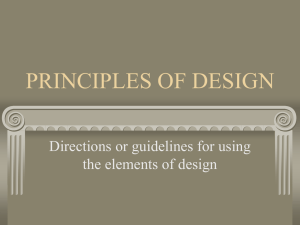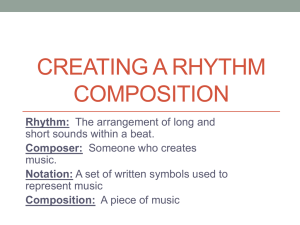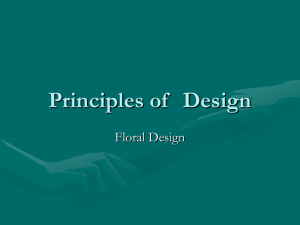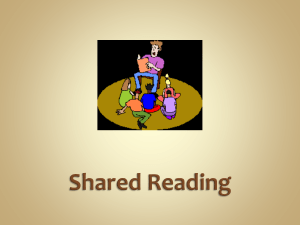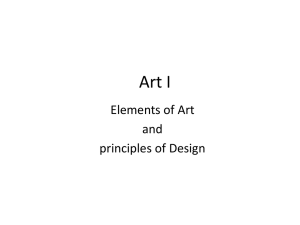Principles of Design: Balance, Rhythm, Scale & More
advertisement
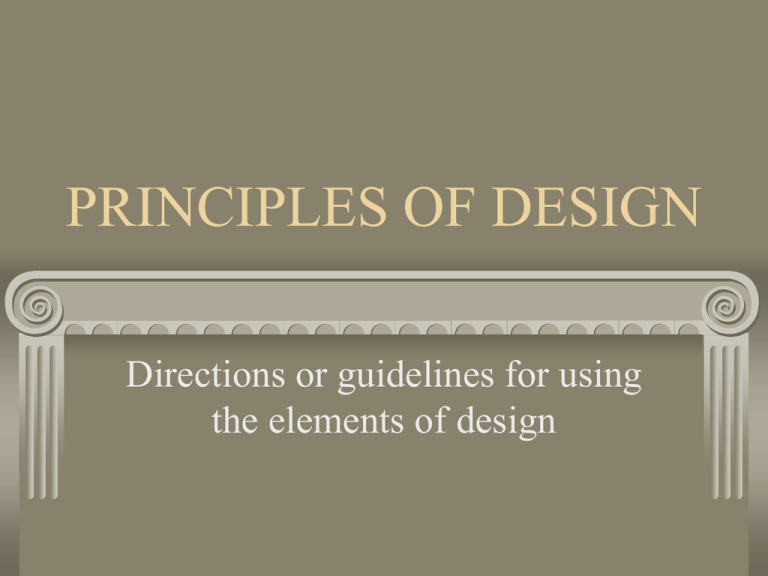
PRINCIPLES OF DESIGN Directions or guidelines for using the elements of design BALANCE A sense of equilibrium. When establishing balance consider visual weight created by size, color, texture and number of objects. TYPES OF BALANCE SYMMETRICAL Achieved by placing identical objects on either side of a central point. ASYMMETRICAL Achieved by placing different objects of equal visual weight on either side of a central point. SYMMETRICAL BALANCE Creates a quiet, restful feeling. Suggests restraint, orderliness, formality. Also called, FORMAL balance. Symmetrical Balance Identical candle sticks, plates, sit on the mantle at each side of the wall mounted mirror. Symmetrical Balance Windows draped in identical fabrics, flank both sides of the grandfather clock. Symmetrical Balance Identical light sconces are placed on both sides of framed picture. Asymmetrical Balance Creates more interesting arrangements. Suggests informality, relaxed. Also referred to as INFORMAL balance. Asymmetrical Balance Mirror is placed off center on the mantle. Tray and bottles on either side of the mirror help to balance it out. Asymmetrical Balance Wall hangings of the same visual weight are hung on each side of the plant stand. Chair balances out the fireplace on the other side of the room. Asymmetrical Balance Items on the mantle are arranged using Asymmetrical Balance. The picture is slightly off center with large plant on the left is balanced by a group of vases on the right. Radial Balance Radial Balance involves having furnishings circular or patterns arranged in a manner. Radiation creates a sweeping, dramatic, circular motion in a room. Radial Balance RHYTHM Leads the eye from one point to another, creates motion. TYPES OF RHYTHM Rhythm by Repetition Rhythm by Gradation Rhythm by Radiation Rhythm by Opposition Rhythm by Transition Rhythm By Repetition Rhythm created by duplicating (repeating) shapes, colors, pattern, line, texture. Beams in the ceiling are repeated. Window panes, repeat. Stripes on ottoman and chair are repeated. Rhythm By Gradation Rhythm created by a gradual change in size or color. Paint on wall changes gradually in value. Rhythm By Radiation Rhythm created by identical objects coming from a central axis. Tall Grasses “radiate” from the center of the vase on this bathroom vanity. Rhythm By Opposition Rhythm created by lines at right angles or contrasting colors. Contrasting black and white tiles and the lines intersecting at right angles. Rhythm By Transition Rhythm created by curved lines that carry your eye across a straight surface. Window treatments that gently swag down, create a soft rhythm by transition. What Type of Rhythm? Repetition? Gradation? Radiation? Opposition? Transition? SCALE & PROPORTION Scale relates to the size of a design in relation to the height and width of the area in which it is placed. Proportion relates to the parts of the object and how one part relates to another. SCALE Relates to the actual and relative size and visual weight of the design and its components. Furniture and accessories must be in scale to the room PROPORTION The Golden Mean – the division of a line or form so that the smaller portion has the same ratio to the larger as the larger has to the whole. Effective Ratios are 2:3, 3:5, 5:8, 4:7, etc. Square is the least pleasing shape. Rectangles are more pleasing, especially with a ratio of 2:3. PROPORTION The creative use of color, texture, pattern, and furniture arrangement can create illusions of properly proportioned space. SCALE & PROPORTION Too Big, Too Small, Just Right This chairs massive scale diminishes everything around it. Too Small. The chairs light palate accentuates its skinny scale. Just Right. This club chair matches the scale of the sofa. Too Big. Coffee table is overscaled for the sofa. Too Small. Table not only looks out of proportion, it functions poorly as well. Just Right. The table is substantial enough to anchor the furniture grouping, yet it leaves room for traffic flow around both ends. Too Tall. Used as an end table, this wood pedestal towers over the sofa, making the sofa appear small and the pairing awkward. Too Short. The lamp would need to be fully stretched to offer good illumination from this low point. Just Right. The perfect pairing, visually and physically, is a tabletop that is a couple of inches shorter than the sofa arm. Too Big. The large-scale motif and strong colors of this floral wallpaper overpower the petite powder room as well as the fixtures and furniture in it. Too Small. The pattern is so small and pale that it almost disappears . Just Right. The narrow contrasting stripes provide the ideal balance for the clean-lined pedestal sink and oversize pine mirror. Too Big. This rug covers too much of the floor beyond the conversation area to define it as a discrete space. Too Small. Instead of creating intimacy, the rug only increases the appearance of isolation. Just Right. Choose an area rug that’s about as long and wide as the furnishings in the space. Too Little. Too much space between objects makes the candlesticks and the too-small frame look lonely, the bare wall yawning above. Too Much. There’s no time to pause to consider any single object, since they are all stepping on one another’s toes in a jostle for space. Just Right. The weight now shifted to the left side, fewer items are needed there for balance. Too Big. There’s no breathing room in this are-to-sofa match. Too Little. This picture is tall enough, roughly matching the height of the sofa. But it ends up looking leggy and lost because it’s too skinny in proportion to the sofa’s width. Just Right. To size a single picture, choose one that’s nearly the same height as the sofa and between half and two-thirds its width. Too Big. This tall lamp towers above the nearby sofa and chair. It is also several inches taller than the table it rests on, throwing the balance off there as well. Too Small. This lamp is overwhelmed by the highback sofa and stocky chair that surround it. Just Right. For the best fit, an end-table lamp should be tall enough to clear the top of the sofa with a little room to spare, yet not so tall that it dwarfs the table it rests on. Too Big. This 5foot-wide double pendant chandelier overpower s the table. Too Small. The fixture is too small to adequately light the table. Just Right. In general, a chandelier’s width or diameter should be at least 2 feet narrower than the table length. Proportion/Scale As a group, make a room that is OUT of proportion/scale. Any type of room will work. The more OUT of proportion the better! Must use a minimum of 15 items. EMPHASIS The center or focus of attention and interest within a design The feature that commands attention and makes a design visually interesting. Emphasis Architectural features such as fireplaces or decorative windows are often used as focal points. Works of art and decorative accessories are often emphasized in a design. WAYS TO CREATE EMPHASIS Arrangement of furniture around a focal point. Use of color, texture, or pattern. Placement of accessories. Use of lighting. Guidelines for Creating Emphasis The point of emphasis should command attention, but not dominate the overall design. Other features within the room should not compete for the emphasis. Harmony There are 2 types of harmony. Unity Variety UNITY Unity occurs when all the parts of a home or room are related by one idea. A unified design has consistency of style VARIETY When two or more different elements of design are used to add interest to a design. Variety can be achieved by combining different styles and materials, as long as they are compatible. HARMONY Is achieved when unity and variety are effectively combined. Carrying variety too far creates confusion. A lack of unity may make a small home seem even smaller. Carriage Bed Lighthouse Jungle Safari Hayloft Mammoth Ice Caves Sports Den Log Cabin Arabian Nights QUESTION? What are the elements of design? List Them (7) What are the principles of design? List Them (5)
